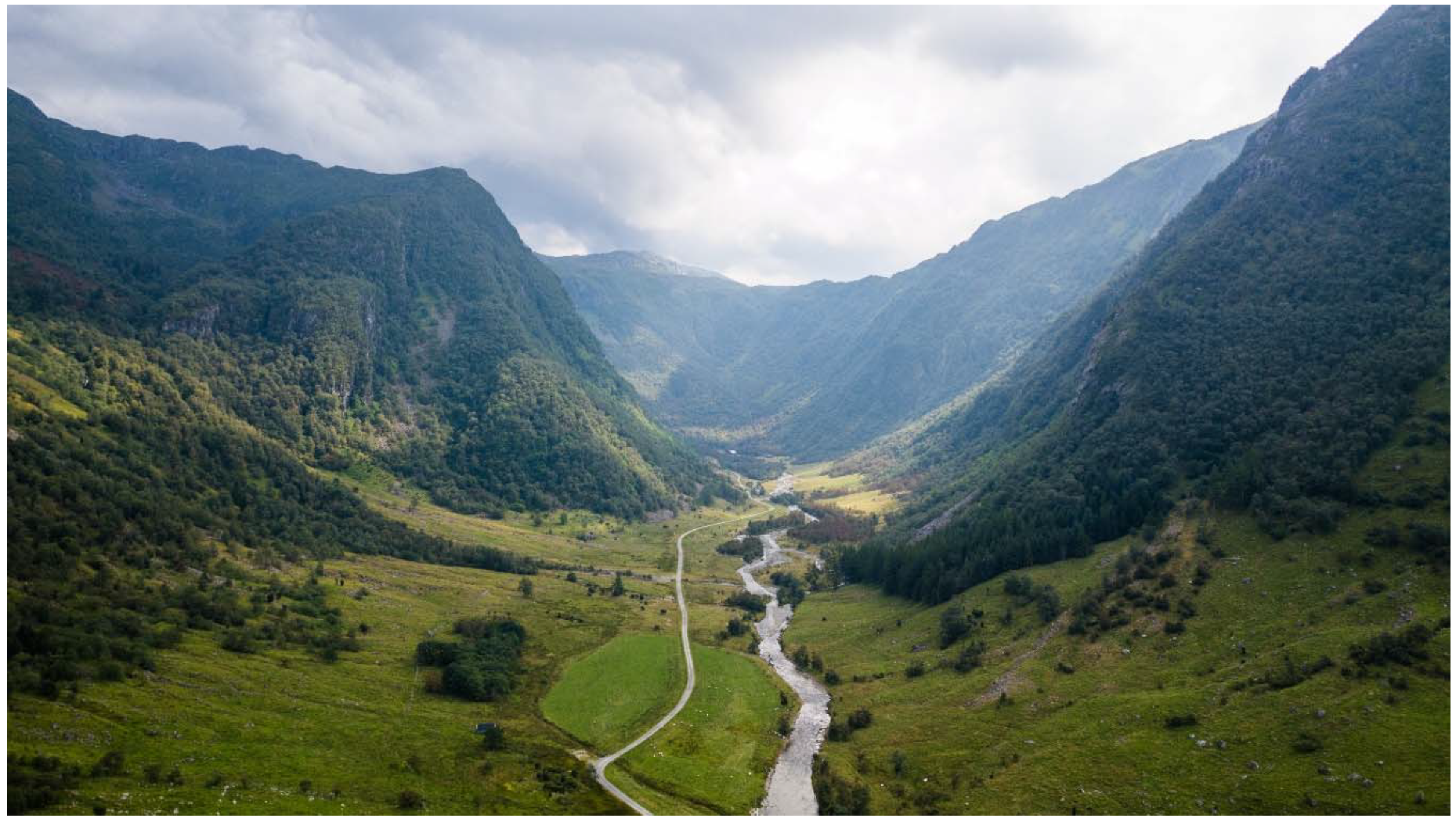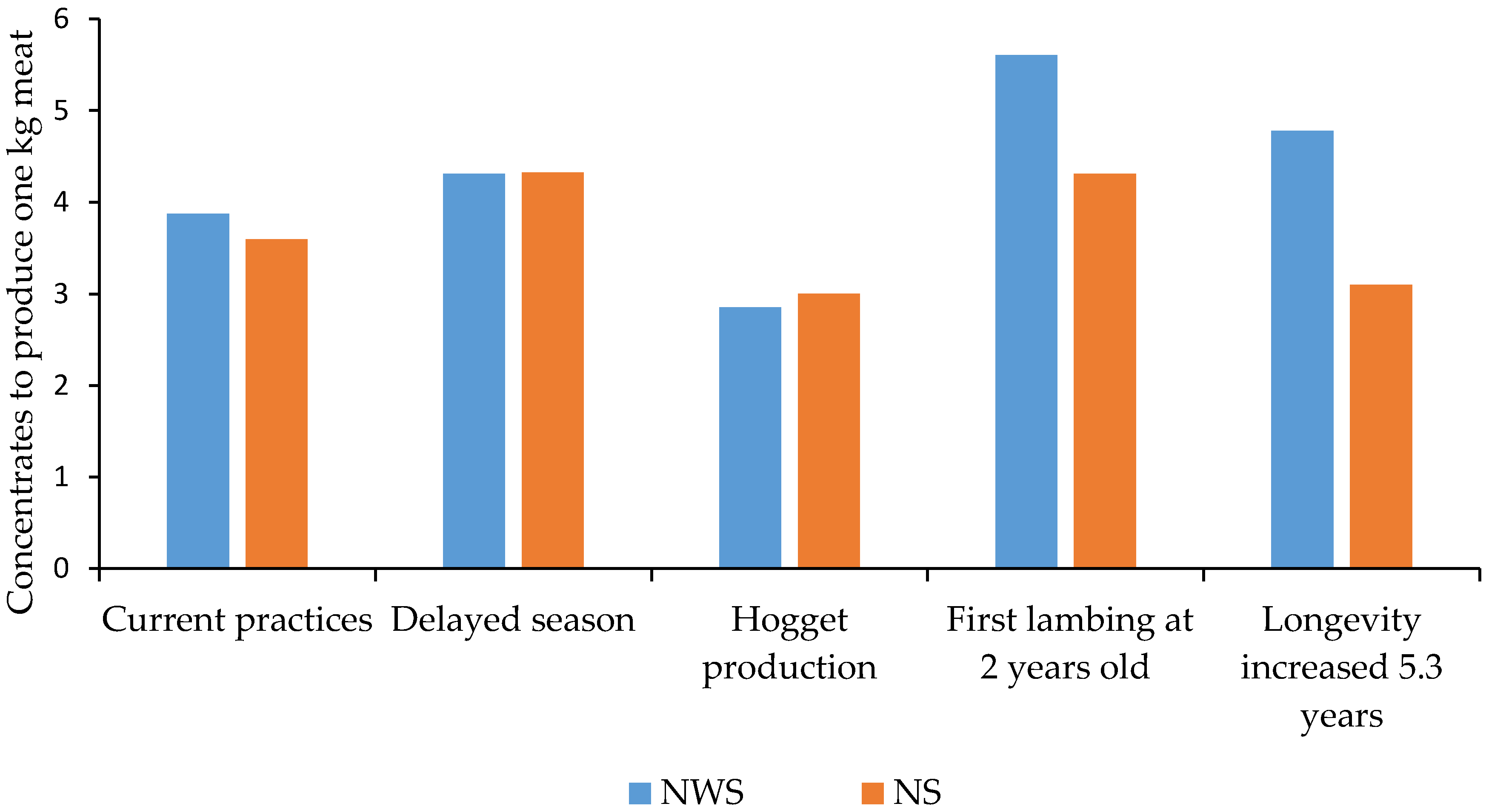Management Strategies to Improve the Economics of Sheep Farms in Norwegian Coastal and Fjord Areas—The Effect of Animal Size and Capacities for Rangeland Utilisation
Abstract
1. Introduction
2. Materials and Methods
- Alternative 1—Delayed season: Delaying lambing for 16 days until the start of grazing (around 1 May) and a corresponding 15 days delay in slaughtering until around 5 October.
- Alternative 2—Hogget production: Overwintering of female lambs and marketing them as hogget in July or August.
- Alternative 3—As with Alternative 2, and with first lambing when 2 years old
- Alternative 4—As with Alternative 3, but assuming longer ewe lifespan. The first lambing at two years of age, and, in addition, increasing the ewe life span to five (5.3) years.
3. Results and Discussion
4. Conclusions
Author Contributions
Funding
Acknowledgments
Conflicts of Interest
References
- Asheim, L.; Mysterud, I. The Norwegian Sheep Farming Production System. Options Méditerranéennes Série A: Séminaires Méditerranéens (CIHEAM). CIHEAM-IAMZ 1999. Available online: https://agris.fao.org/agris-search/search.do?recordID=QC1999000167 (accessed on 29 April 2020).
- Steinheim, G.; Nordheim, L.; Weladji, R.; Gordon, I.J.; Ådnøy, T.; Holand, Ø. Differences in choice of diet between sheep breeds grazing mountain pastures in Norway. Acta Agric. Scand. Sect. A Anim. Sci. 2005, 55, 16–20. [Google Scholar] [CrossRef]
- Bhatti, M.A.; Williams, T.; Hopkins, D.L.; Asheim, L.J.; Steinheim, G.; Campbell, M.; Olav, L.; Wynn, P.C.; Ådnøy, T. Adapting Seasonal Sheep Production to Year-Round Fresh Meat and Halal Market in Norway. Sustainability 2019, 11, 1554. [Google Scholar] [CrossRef]
- Animalia. Annual Report, The Sheep Rececording Scheme. 2018. Available online: https://www.animalia.no/no/Dyr/husdyrkontrollene/sauekontrollen/arsmeldinger/ (accessed on 31 March 2020).
- Lillehammer, M. Lammeproduksjon i forhold til kroppsvekt hos sau. (Lamb Production Related to the Body Weight of the ewe). Master’s Thesis, Norwegian University of life sciences (NMBU), Ås, Norway, 2004. Available online: https://docplayer.me/549613-Lammeproduksjon-i-forhold-til-kroppsvekt-hos-sau-lamb-production-related-to-the-body-weight-of-the-ewe-foto-t-a-s-lillehammer.html (accessed on 12 February 2020).
- Jørgensen, N.H.; Steinheim, G.; Holand, Ø. Area use of two sheep breeds in contrasting summer alpine grazing environments in southern Norway. Acta Agric. Scand. Sect. A Anim. Sci. 2016, 66, 1–7. [Google Scholar] [CrossRef]
- Fowler, S.M.; Hoban, J.; Melville, G.; Pethick, D.W.; Morris, S.; Hopkins, D.L. Maintaining the appeal of Australian lamb to the modern consumer. Anim. Prod. Sci. 2018, 58, 1392–1398. [Google Scholar] [CrossRef]
- Steinheim, G.; Ødegård, J.; Ådnøy, T.; Klemetsdal, G. Genotype by environment interaction for lamb weaning weight in two Norwegian sheep breeds1. J. Anim. Sci. 2008, 86, 33–39. [Google Scholar] [CrossRef] [PubMed]
- Stenheim, G.; Nordheim, L.; Weladji, R.; Holand, Ø.; Ådnøy, T. Digestive Tract Anatomy of Norwegian Sheep: Difference Between Breeds. Acta Agric. Scand. Sect. A Anim. Sci. 2003, 53, 155–158. [Google Scholar] [CrossRef]
- Bhatti, M.A.; Øvrum Gaarder, M.; Steinheim, G.; Hopkins, D.L.; Horneland, R.; Eik, L.O. Lamb or Hogget Meat—A Different Sensory Profile? Extending the Fresh Meat Season in Norway. Small Rumin. Res. 2020, 185, 106086. [Google Scholar] [CrossRef]
- Asheim, L.J.; Thorvaldsen, P.; Rivedal, S. Policy measures to preserve Norwegian coastal and fjord landscapes in small-scale farming systems. Environ. Sci. Policy 2020, 104, 43–51. [Google Scholar] [CrossRef]
- Luenberger, D.G.; Ye, Y. Linear and Nonlinear Programming; Springer Science and Business Media LLC: Berlin, Germany, 2008. [Google Scholar]
- Madsen, J.; Hvelplund, T.; Weisbjerg, M.R.; Bertilson, J.; IOlsson Spørndly, R. The AAT/PBV protein evaluation system for ruminants. A revision. Nor. J. Agric. Sci. 1995, (Suppl. 19), 1–37. Available online: https://jukuri.luke.fi/handle/10024/466537 (accessed on 29 April 2020).
- Kyriazakis, I.; Zervas, G. Organic Meat and Milk from Ruminants. In Proceedings of the Joint International Conference Organised by the Hellenic Society of Animal Production and the British Society of Animal Science, Athens, Greece, 4–6 October 2001; Wageningen Academic Pub: Wageningen, The Netherlands, 2002. [Google Scholar]
- Blagosklonny, M.V. Big mice die young but large animals live longer. Aging 2013, 5, 227–233. [Google Scholar] [CrossRef] [PubMed][Green Version]
- Getachew, T.; Gizaw, S.; Wurzinger, M.; Haile, A.; Rischkowsky, B.; Okeyo, A.; Sölkner, J.; Mészáros, G. Survival analysis of genetic and non-genetic factors influencing ewe longevity and lamb survival of Ethiopian sheep breeds. Livest. Sci. 2015, 176, 22–32. [Google Scholar] [CrossRef]


| Description | NOK | Description | NOK |
|---|---|---|---|
| Basic price cull ewe meat, per kg | 7.18 | Support per sheep, 1–150 | 883 |
| Basic price hogget, per kg | 10.28 | Support per sheep, >150 | 194 |
| Basic price lamb, per kg | 66.10 | Lamb support, grade O, per carcass | 450 |
| Basic support meat, per kg | 3.81 | Lamb support, grade <O, per carcass | 41 |
| Shearing costs, per kg of meat | 0.52 | Concentrate Lamb, (92, 11) * per kg | 3.69 |
| Wool, per kg | 53.8 | Concentrate Fibre, (86, 11) * per kg | 3.72 |
| Relief support, per sheep | 458 | Concentrate Sheep, (96, 12) * per kg | 4.21 |
| Grazing farmland, per animal | 50 | Diesel, per Liter | 11.52 |
| Grazing rangeland, per animal | 205 | Mineral fertiliser, 22-2-12, per kg | 3.72 |
| Alternative Scenarios | Description |
|---|---|
| 1. Delayed season | Delayed lambing for 16 days until the start of grazing (around 1 May) and a corresponding 15 days delay in slaughtering until around 5 October. |
| 2. Hogget production | Overwintering of surplus female lambs and marketing them as hogget in July or August. |
| 3. First lambing when 2 years old | As with Alternative 2, but with first lambing when ewe is 2 years old. |
| 4. Longevity increased to 5.3 years | As with Alternative 3, but assuming longer ewe lifespan (5.3 years). |
| Gross Margin, 1000 NOK | Breeding Sheep | Hoggets for Meat | Lambs (0–1 years) | Hired Work, (hours) | |
|---|---|---|---|---|---|
| Current practice, lifespan 3.3 years | 401 | 119 | 0 | 53 | 570 |
| Alternative scenarios a | |||||
| 1. Delayed season | 369 | 116 | 0 | 52 | 510 |
| 2. Hogget production | 279 | 99 | 52 | 44 | 593 |
| 3. First lambing when 2 years old | 354 | 157 | 0 | 70 | 693 |
| 4. Longevity increased to 5.3 years | 417 | 163 | 0 | 38 | 612 |
| Gross Margin, 1000 NOK | Breeding Sheep | Hoggets for Meat | Lambs (0–1 years) | Hired Work (hours) | |
|---|---|---|---|---|---|
| Current practice, lifespan 3.3 years | 423 | 132 | 0 | 59 | 754 |
| Alternative scenarios a | |||||
| 1. Delayed season | 389 | 134 | 0 | 59 | 763 |
| 2. Hogget production | 372 | 112 | 59 | 50 | 583 |
| 3. First lambing when 2 years old | 388 | 160 | 0 | 72 | 593 |
| 4. Longevity increased to 5.3 years | 451 | 163 | 0 | 38 | 718 |
| Concentrates FEm */Sheep | Roughage FEm */Sheep | Yield FEm */ha | Concentrates FEm */kg Meat (overall) | |
|---|---|---|---|---|
| Current practice, lifetime 3.3 years | 98 | 348 | 2699 | 3.59 |
| Alternative scenarios a | ||||
| 1. Delayed season | 117 | 325 | 2550 | 4.33 |
| 2. Hogget production | 105 | 409 | 2700 | 3.00 |
| 3. First lambing when 2 years old | 81 | 285 | 2694 | 4.31 |
| 4. Longevity increased to 5.3 years | 68 | 330 | 2701 | 3.10 |
| Gross Margin, 1000 NOK | Breeding Sheep | Roughage FEm */Sheep | Concentrates FEm */kg Meat | |
|---|---|---|---|---|
| Current practice, lifetime 3.3 years | 22 | 13 | −39 | −0.28 |
| Alternative scenarios a | ||||
| 1. Delayed season | 20 | 17 | −55 | −0.02 |
| 2. Hogget production | 94 | 13 | −58 | 0.15 |
| 3. First ambing when 2 years old | 34 | 3 | −11 | −1.30 |
| 4. Longevity increased to 5.3 years | 33 | 0 | −1 | −1.68 |
© 2020 by the authors. Licensee MDPI, Basel, Switzerland. This article is an open access article distributed under the terms and conditions of the Creative Commons Attribution (CC BY) license (http://creativecommons.org/licenses/by/4.0/).
Share and Cite
Bhatti, M.A.; Eik, L.O.; Steinheim, G.; Ådnøy, T.; Hopkins, D.L.; Asheim, L.J. Management Strategies to Improve the Economics of Sheep Farms in Norwegian Coastal and Fjord Areas—The Effect of Animal Size and Capacities for Rangeland Utilisation. Sustainability 2020, 12, 3713. https://doi.org/10.3390/su12093713
Bhatti MA, Eik LO, Steinheim G, Ådnøy T, Hopkins DL, Asheim LJ. Management Strategies to Improve the Economics of Sheep Farms in Norwegian Coastal and Fjord Areas—The Effect of Animal Size and Capacities for Rangeland Utilisation. Sustainability. 2020; 12(9):3713. https://doi.org/10.3390/su12093713
Chicago/Turabian StyleBhatti, Muhammad Azher, Lars Olav Eik, Geir Steinheim, Tormod Ådnøy, David L. Hopkins, and Leif Jarle Asheim. 2020. "Management Strategies to Improve the Economics of Sheep Farms in Norwegian Coastal and Fjord Areas—The Effect of Animal Size and Capacities for Rangeland Utilisation" Sustainability 12, no. 9: 3713. https://doi.org/10.3390/su12093713
APA StyleBhatti, M. A., Eik, L. O., Steinheim, G., Ådnøy, T., Hopkins, D. L., & Asheim, L. J. (2020). Management Strategies to Improve the Economics of Sheep Farms in Norwegian Coastal and Fjord Areas—The Effect of Animal Size and Capacities for Rangeland Utilisation. Sustainability, 12(9), 3713. https://doi.org/10.3390/su12093713







